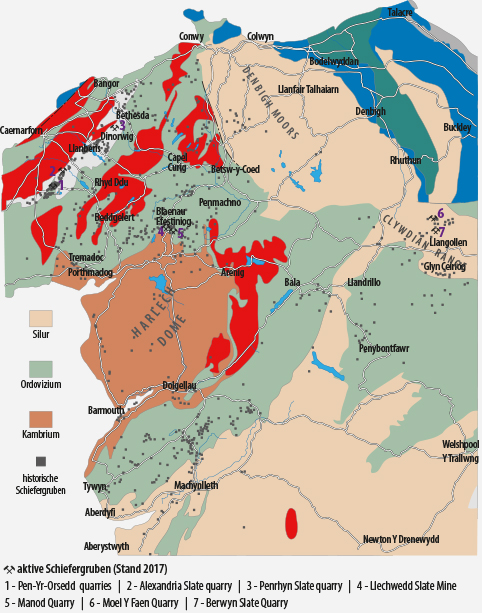 |
||
|
Slate deposits of Wales [UK]
The Welsh basin with its primary Cambrian to Ordovician rocks is situated within the 'Southern Britain Terrane' which is separated from the basin of the Lake District (= 'Lakesman Terrane') by the 'Monian Terrane'.
At the southern rim of the basins a highland is observable which can be reconstruct from Pembrokshire to Manchester (Schönenberg & Neugebauer, 1987). The roofing slate deposits are situated within Cambrian, Ordovician and Silurian units and are mostly found in Northern Wales. The main deformation occurred during the Silurian, from Llandoverian to post-Ludlowian and the metamorphic facies ranges within the 'low grade zeolite facies' (Dunning 1992,compare Fig..). The multiple deformation led to the formation of anti- and synclines, folds with different styles and thrusts of Early-Paleozoic rock units. This folding was accompanied by the formation of a penetrative and well developed fracture cleavage. This fracture cleavage is the basis for the origin of (roofing-) slates and is partly overprinted by a crenulation foliation or multiple other foliations.
The Welsh basin is devised in anticlines and synclines with a strike from NW to SE in the southern part, corresponding to the general strike of the basin. Central and SW-Wales is dominated by the 'Towy'- and 'Teifi Anticline' which are again separated by the 'Central Wales Syncline'. The fracture cleavage varies from a moderate to steep inclination. According to Coward & Siddans (1979), the most intense strain was observed in the center of Snowdonia with a decrease to Northeast and Southwest.

The Cambrian Slates
The Cambrian slates are within the 'Caernarvorshire (Gwynedd) Slate Belt' in N-Wales, within the 'Llanberis Slates' of the Lower Cambrian 'Comley Series'. The 'Llanberis Slates' can reach a thickness up to 3,300 ft. and are probably distal turbidites, representing the culmination of the general trend to a deep sea sedimentation (Cowie, 1992). Slates, for example, were mined in the 'Moel Tryfan Quarry' and show a fine grained sedimentary pattern with a well developed fracture cleavage (Cowie, 1992). According to Cowie (1992), the slates are overlaid by the 'Dorothea Grit' which gradually passes into the 'Striped Blue Slate'.
The Cambrian slates are still mined at Bethesda, Llanberis, Moel Tryfan and Nantlle/Penygroes with the 'Penrhyn Quarry' or the 'Diwornic Quarry' as the most famous quarries during the 20ies of the 19th century.
The Ordovician Slates
Ordovician slates are within the 'Dolgellau Formation' of the Tremadocian, which in former times were described as 'Dollgelly Beds'. This rocks are sediments of a open shallow-marine environment with striking differences in thickness along synsedimentary faults (Howells & Smith, 1997 cited in Rushton et al., 1999). The 'Dolgellau Formation' shows a thickness of about 500 ft. and the profile at Bryn-llin-fawr contains at the bottom hard black mudstones with siltic gray intercalations which are cleaved and show a great angle between bedding and fracture cleavage. This rocks are overlaid by grey to black shales with only a weakly developed cleavage plane which is parallel to bedding. To the hanging layer silty mudstones, tuffaceous sandstones (about 33 ft. thick) and hard black shales follow. According to North (1927), the most valuable Ordovician slates are mined in the vicinity of Blaenau Ffestiniog. They are more fine grained as those of Bethesda/Nantlle and show a grey to blue colour with a partly shining surface. This slates were mined in at least seven and between 30-148 ft. thick slate beds which are separated by intercalations of sandstone. The fracture cleavage is only partly well developed and thus the mining of thin splitting slate was very selective. Most of the slates were mined by underground mining and carried to the port of Portmadoc for further shipping or transported by train throughout Great Britain, respectively. A very dark slate was mined in the famous quarries of Penmachno and Dolwyddelan (Prince Llewellyn). Other Upper-Ordovician slates were mined within the about 1,476 ft. thick 'Bala Formation' between Abergynolwyn-Corris and Aberllefenni. As in the other area, the light- to dark bluish slates were selectively mined because of the differently developed fracture cleavage. It was mined at Llangynog for centuries but lost its economic importance already at the beginning of the 20th century. Another important slate district of Ordovician slates lies at the Prescelly Mountains, Pembrokshire and the adjacent regions of Carmartenshire and Cardiganshire. This slates of the 'Llandeilo Series' have an olive-green to grey colour which were caused by volcanic ashes. North of Pembrokshire one can find Ordovician Slates (Arenigian-Llanvirnian) which are intensely cleaved and show a dark black colour. North (1927) reports of other slates which either easily weather, turn to rusty colour or are too soft in order to be used as roofing slate.
The Silurian Slates The Silurian slates have never reached the economic importance like the Cambrian and Ordovician slates. One can separate two districts. In the northern district within the Clywdian Range slate of Wenlock-Ludlow was mined. In the area of the Clywdian Range the Silurian comprises greywackes, mudstones and graptolithic slate. The southern slate district between Corris and Machynlleth are of Llandoverian age. Here one can find dark-grey slates with a steep fracture cleavage which rapidly alternate with non cleaved laminated siltstones. Because the slates are too thick after splitting they were not used for roofing. |
||||||||||||||||||